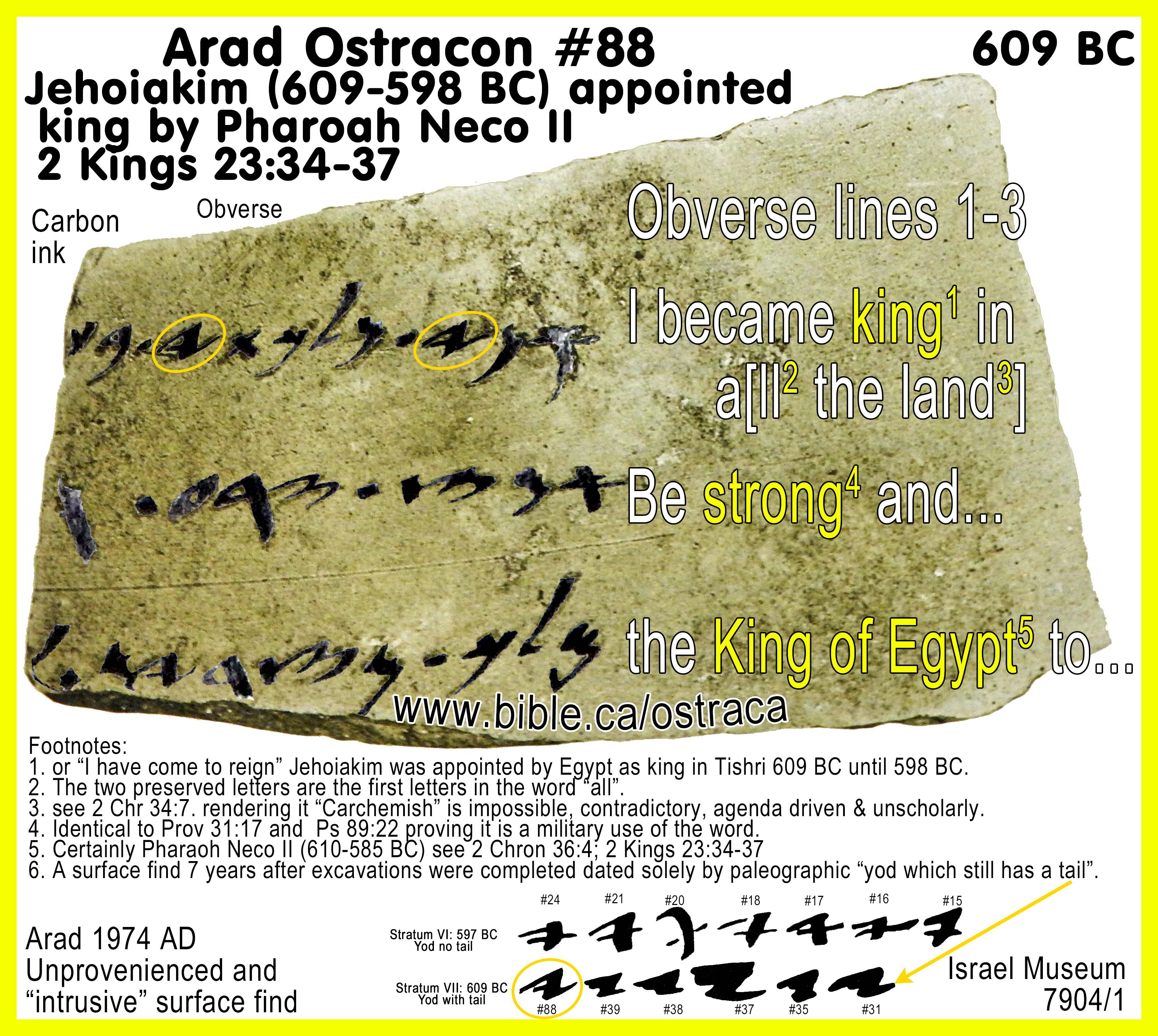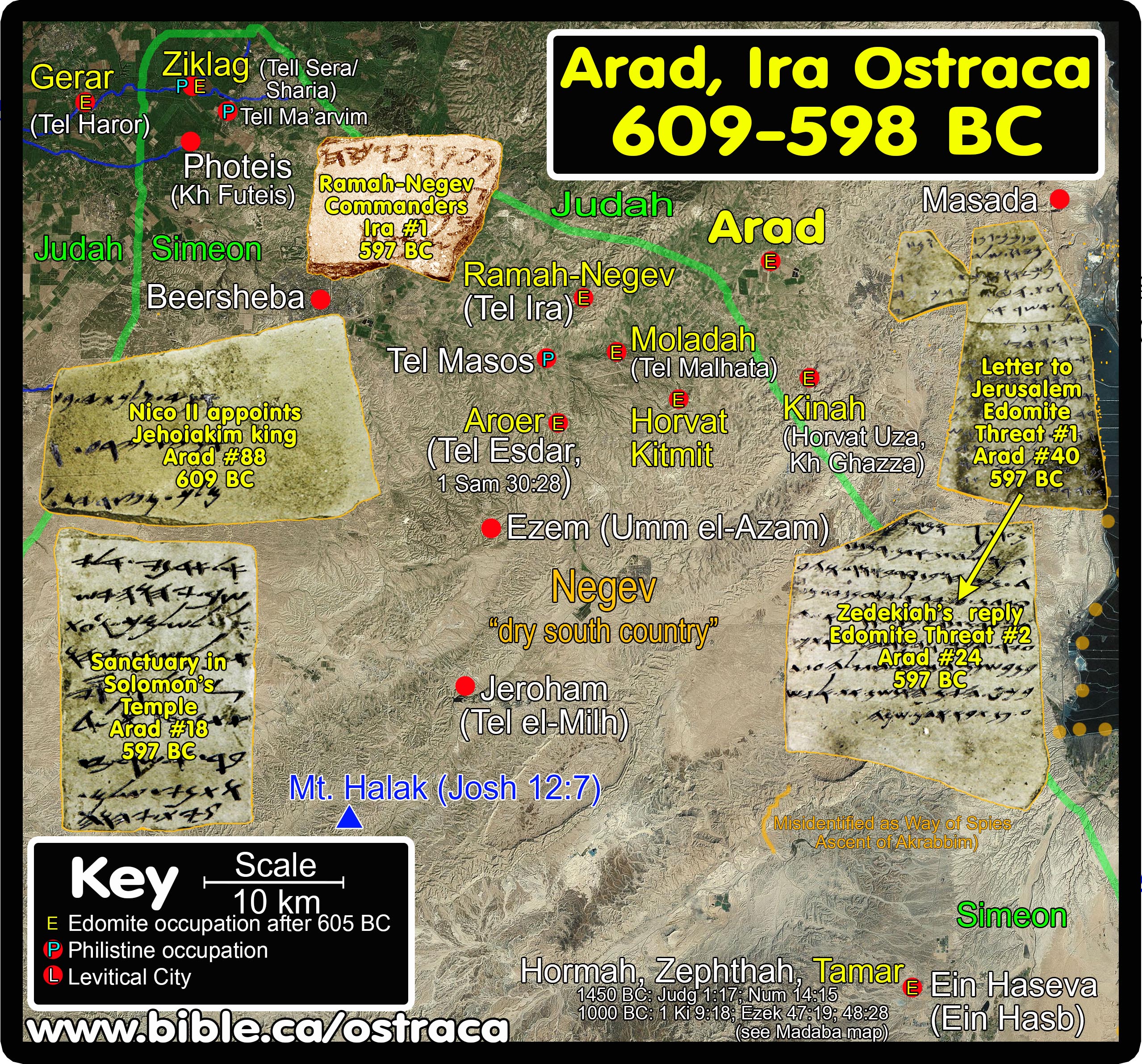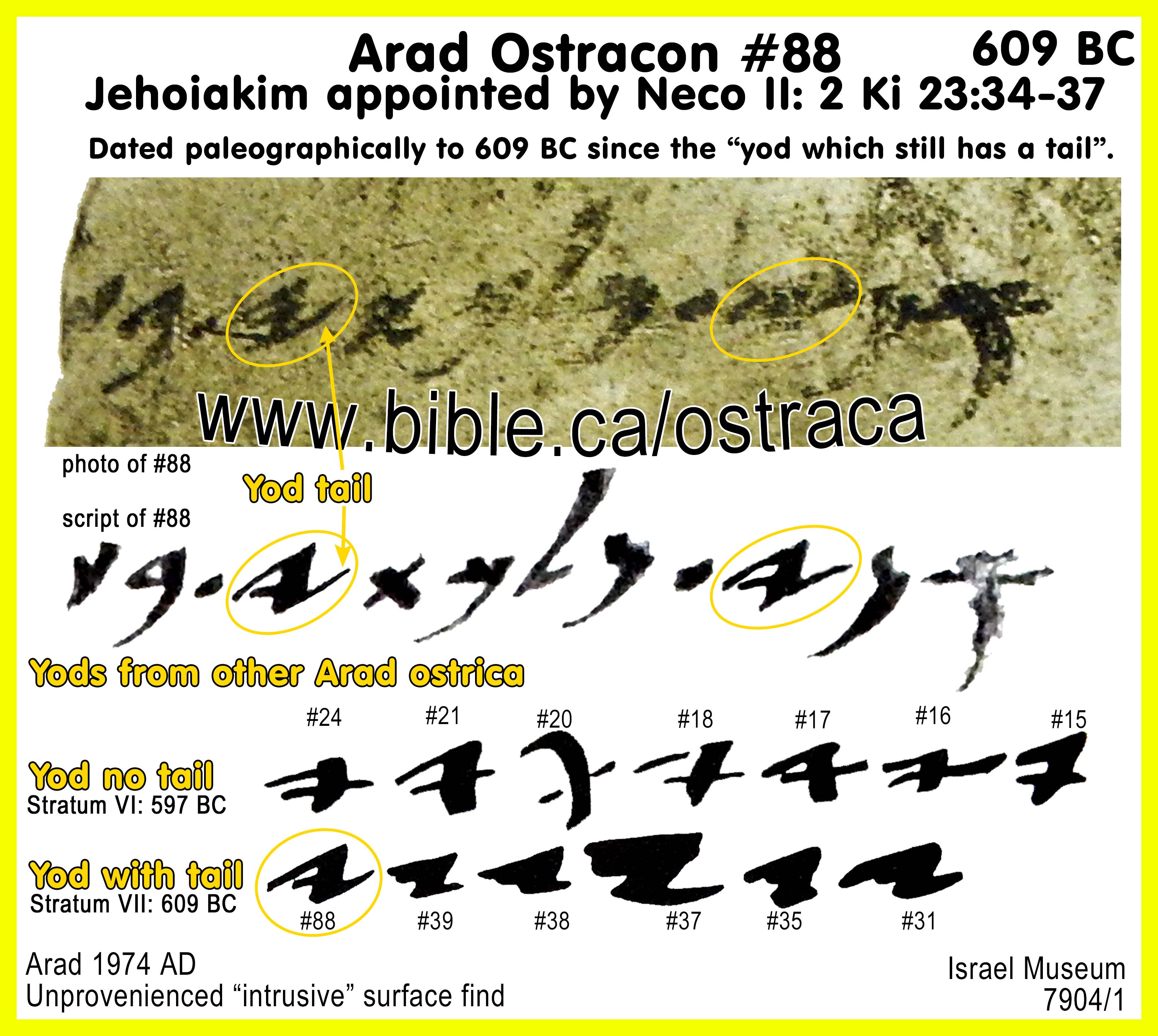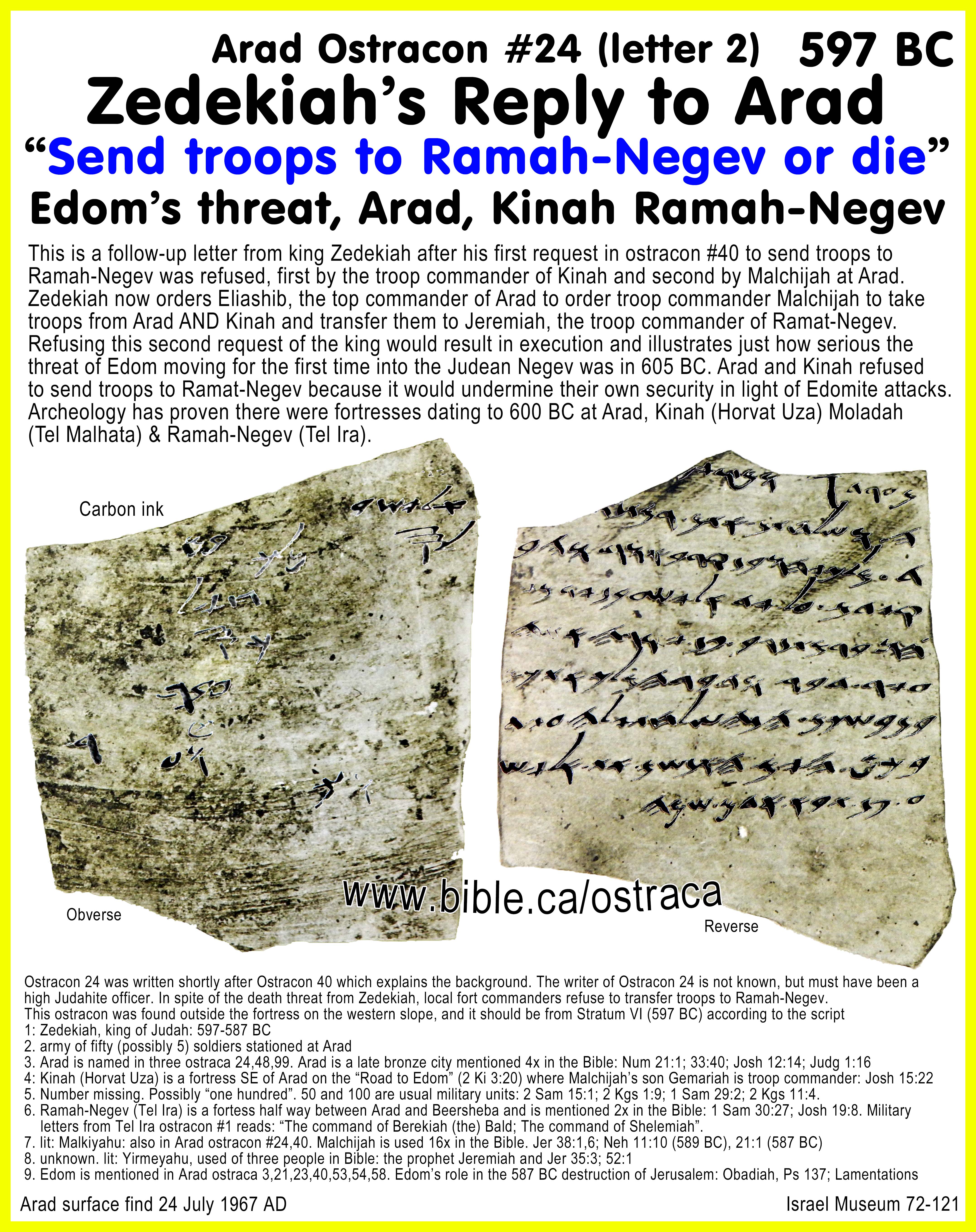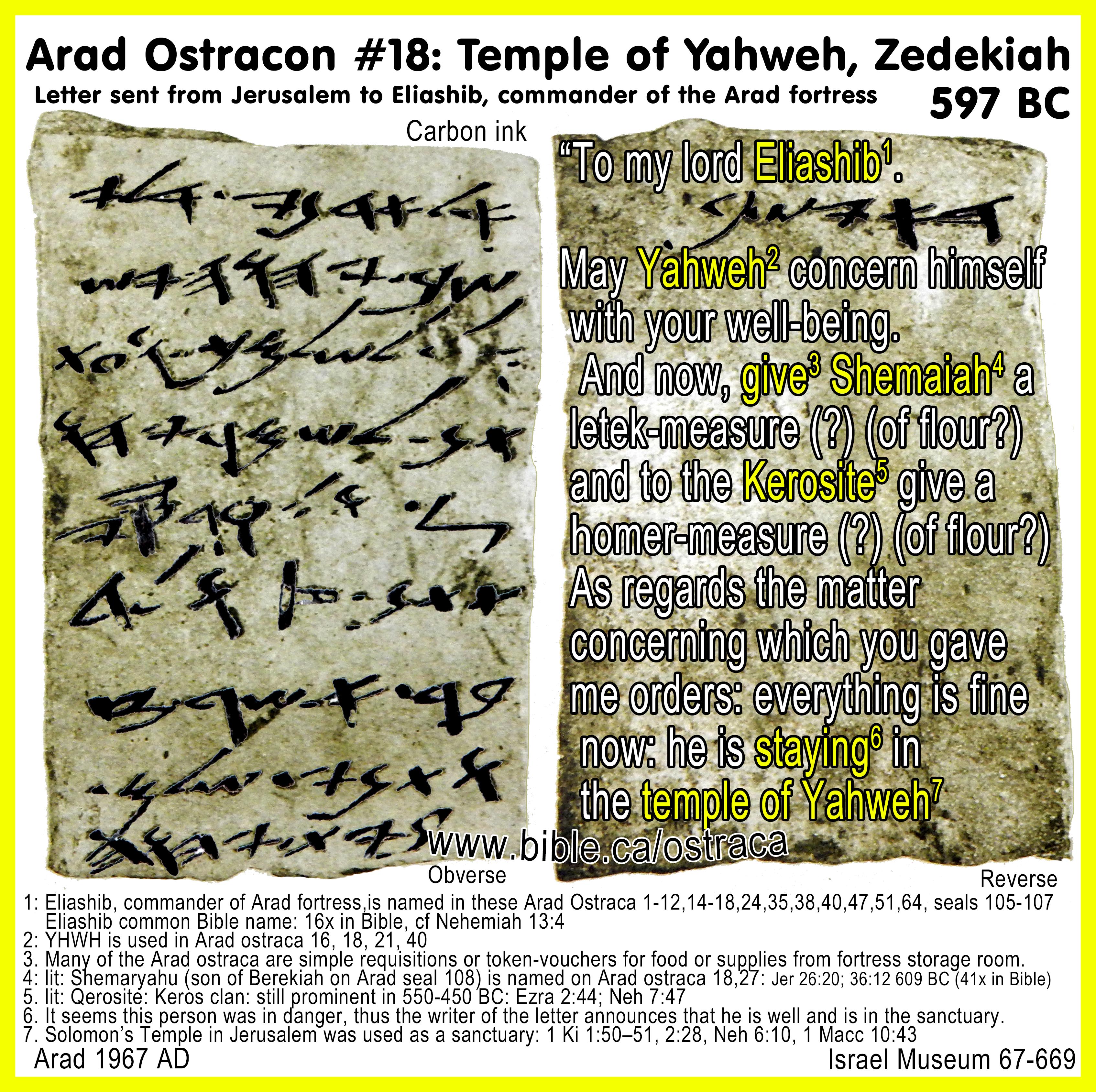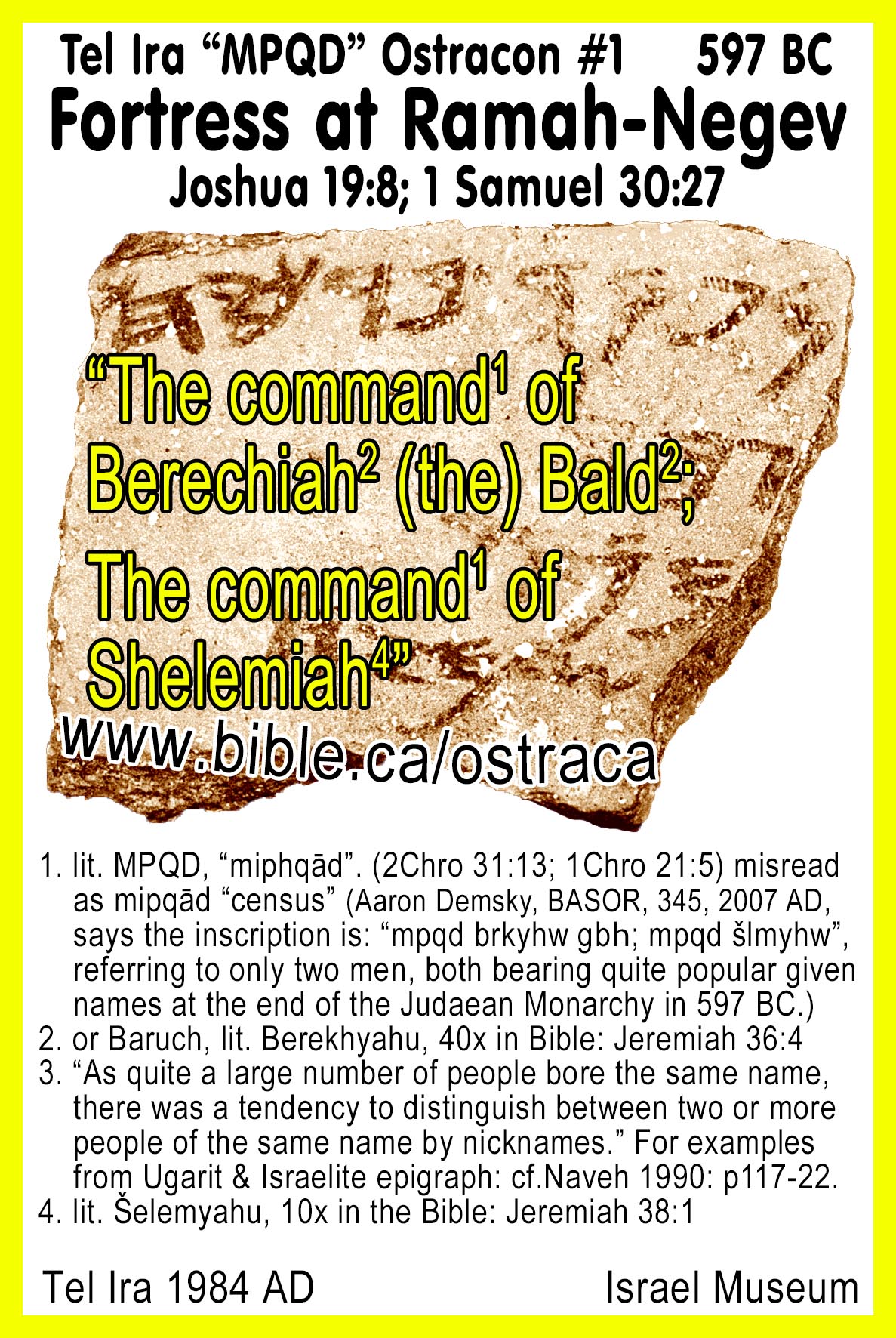Arad Ostraca #88 (609 BC)
Pharaoh Neco II appoints Jehoiakim king of Judah: 2 Kings 23:34-37
Jehoiakim was appointed by Egypt as king in Tishri 609 BC until 598 BC
Ostraca, Tablets and Inscriptions of the Bible
|
Digging up Bible stories! 5 ostraca document 3 important Bible events: 1. Pharaoh Nico II appoints Jehoiakim king of Judah in 609 BC. 2. Edomites move into the Judean Negev and Zedekiah orders troops for defense. 3. A man seeks asylum in the temple of Solomon. See also: Outline on Josiah King of Judah (640-609 BC) Outline on Jehoiakim king of Judah (609-598 BC) Outline on Zedekiah King of Judah (597-587 BC) Outline on Gedaliah 1st Governor of Judah (587 BC) "What we read in the book, we find in the ground" |
Click here for SPECIAL INTRODUCTION TO ALL ARAD OSTRACA
|
|
|
Arad Ostracon #88: Egypt appoints Jehoiakim |
|
|
Introduction to Arad ostracon #88:
- Read first to understand Arad ostracon #88 better: Archeological introduction to Arad Ostraca
- In this spectacular archeological glyptic artifact we have a record, on a piece of broken pottery written in carbon black ink, the actual announcement Jehoiakim sent throughout his kingdom that Egyptian pharaoh Niko II had appointed him as king of Judah in place of Jehoahaz in 609 BC.
- Jehoiakim was appointed by Egypt as king in Tishri 609 BC until 598 BC.
- This is like a broadcast email announcement.
- "Pharaoh Neco made Eliakim the son of Josiah king in the place of Josiah his father, and changed his name to Jehoiakim. But he took Jehoahaz away and brought him to Egypt, and he died there. So Jehoiakim gave the silver and gold to Pharaoh, but he taxed the land in order to give the money at the command of Pharaoh. He exacted the silver and gold from the people of the land, each according to his valuation, to give it to Pharaoh Neco. Jehoiakim was twenty-five years old when he became king, and he reigned eleven years in Jerusalem; and his mother’s name was Zebidah the daughter of Pedaiah of Rumah. He did evil in the sight of the Lord, according to all that his fathers had done." (2 Kings 23:34–37)
- "The king of Egypt made Eliakim his brother king over Judah and Jerusalem, and changed his name to Jehoiakim. But Neco took Joahaz his brother and brought him to Egypt. Jehoiakim was twenty-five years old when he became king, and he reigned eleven years in Jerusalem; and he did evil in the sight of the Lord his God. Nebuchadnezzar king of Babylon came up against him and bound him with bronze chains to take him to Babylon." (2 Chronicles 36:4–6)
- Translation of Arad ostracon #88:
- "I became king1 in a[ll2 the land3] Be strong4 and... the King of Egypt5 to... Obverse lines 1-3
- For red footnotes see below.
- Brackets […] indicate missing, damaged or unreadable text.
I. The discovery of Arad ostracon 88: Provenanced yes! Provenienced no!
- Arad ostracon 88 is a provenanced surface find but it is unprovenienced.
- The ostracon was discovered by Israel Sommer in 1974 when we walked the entire site and randomly picked up surface pottery and putting all the pieces into a single bag without marking where each piece was found on tel Arad. Later that day at Engedi, Israel Sommer washed his pottery and only then discovered the inscription on the broken pottery sherd which became Arad ostracon 88.
- So while Arad ostraca 88 is "unprovenienced" (lacking 3 a dimensional record of where it was found within a formal archeological dig), it is not "unprovenanced" since surface finds on archeological sites are often and routinely added to the official excavation records.
- What the excavation report said:
- "The last ostracon (No. 88) was not found during the excavations, but was discovered in March 1974 by Israel Sommer of the Ein Gedi Field School during a visit at the tell. Although remains of only three lines were preserved, these lines are clearly part of a letter from the king of Judah to the fortress commander; according to the handwriting, it must come from Stratum VII. This is an important addition to the collection of ostraca." (Arad inscriptions, Joseph Yohanan Naveh, p5, 1981 AD)
- "This ostracon was found on the ground on Passover Eve, 1974, after this volume was ready for publication. According to the script, it is clear that it belongs to Stratum VII, and vid. especially the yod which still has a tail, but the two upper horizontal strokes make a sort of triangle in which the upper line is longer and somewhat rounded. The beginnings of three lines of script were preserved, and all the letters are clear." (Arad Inscriptions, Yohanan Aharoni, Arad inscription 88, p 103, 1981 AD)
- "Footnote 1. The ostracon was found during a visit to the tell by Israel Sommer from the Ein Gedi Field School, and was given to me a few days later, on Passover Eve, 1974, via Pesah Bar-Adon. Unfortunately, we do not know for certain in which of the rooms of the citadel it was found, since Sommer picked up sherds from all over the citadel and noticed the inscription only after the washing up at Ein Gedi. (Arad Inscriptions, Yohanan Aharoni, Arad inscription 88, p 104, 1981 AD)
II. Translation of Arad ostracon #88:
|
Obverse lines 1-3
"I became king1 in a[ll2 the land3] Be strong4 and... the King of Egypt5 to..."
(Steve Rudd adapted from Aharoni) For red footnotes see below. Brackets […] indicate missing, damaged or unreadable text. |
|
|
Steve Rudd's red footnotes from his adapted translation above
|
|
A. Translation notes from: Arad Inscriptions, Yohanan Aharoni, Arad inscription 88, p 103, 1981 AD
Aharoni translation: "I became king in a[ll the land] (or I have come to reign) Take strength and... King of Egypt to..." (Arad Inscriptions, Yohanan Aharoni, Arad inscription 88, p 103, 1981 AD)
1. The excavation reports for Arad Ostracon #88 are:
a. Arad was excavated 1962-1967 AD.
b. Arad Inscriptions, Yohanan Aharoni, Arad inscription 40, p 70, 1981 AD (The Hebrew version was published years earlier, but the English edition has many updates and corrections)
c. Three Hebrew Ostraca from Arad, Y. Aharoni, BASOR 197, p 28, 1970 AD
2. "This ostracon was found on the ground on Passover Eve, 1974, after this volume was ready for publication. According to the script, it is clear that it belongs to Stratum VII, and vid. especially the yod which still has a tail, but the two upper horizontal strokes make a sort of triangle in which the upper line is longer and somewhat rounded." (Arad Inscriptions, Yohanan Aharoni, Arad inscription 88, p 103, 1981 AD)
3. "The beginnings of three lines of script were preserved, and all the letters are clear." (Arad Inscriptions, Yohanan Aharoni, Arad inscription 88, p 103, 1981 AD)
4. "From this, it is possible to deduce that the letter was sent to the commander of the citadel, Eliashib son of Eshiyahu, from Jehoahaz son of Josiah, King of Judah, during his short reign of three months after the death of his father at Megiddo (2 Kgs 23:31; 2 Chr 31:2). Jehoahaz tells Eliashib that he has become king after his father's death, and asks him to prepare for war with the return of Pharaoh Necoh, who has meanwhile gone to Harran. If the completion "in all Eretz-Israel" is correct, and it is difficult to imagine any other, then here we have epigraphic evidence that Josiah ruled not only over Judah, but over the whole of Eretz-lsrael. According to the Bible, Josiah's purification of the cult took place in all Eretz-Israel" (2 Chi- 34:7). His son Jehoahaz demanded for himself the succession to all of his father's kingdom, including both Israel and Judah, thus the emphasis on the boundaries of his kingdom. This letter corroborates our conclusion that Stratum VII was destroyed in the year 609 B.C.E. by the Egyptians, following Jehoahaz's surrender and the crowning of his brother Eliakim-jehoiakim as an Egyptian protégé." (Arad Inscriptions, Yohanan Aharoni, Arad inscription 88, p 103, 1981 AD)
B. Line by line commentary: Arad Inscriptions, Yohanan Aharoni, Arad inscription 88, p 103, 1981 AD
1. Line 1. "I have come to reign", that is, "I became king". Compare this to the Mesha stone. Thus it appears that this was a letter from the king, in which he announces to the commander of the citadel that he has taken the throne. At the end of the line, two letters were preserved, which possibly should be completed: [Into "in all the land" or "in all EretzIsrael" (cf. 2 Chr 34:7).
2. Line 2. This idiom appears in the Bible only in poetical passages "And maketh strong her arms", Prov 31:17; "Mine arm shall strengthen him", Ps 89:22. But there is no doubt that "to become strong" is meant, in other words, energetic military preparedness.
3. Line 3. The mention of the "King of Egypt" is no doubt connected with the preceding lines, i.e., the crowning of a new king and the need for military preparedness.
C. Footnotes: Arad Inscriptions, Yohanan Aharoni, Arad inscription 88, p 103, 1981 AD
1. The ostracon was found during a visit to the tell by Israel Sommer from the Ein Gedi Field School, and was given to me a few days later, on Passover Eve, 1974, via Pesah Bar-Adon. Unfortunately, we do not know for certain in which of the rooms of the citadel it was found, since Sommer picked up sherds from all over the citadel and noticed the inscription only after the washing up at Ein Gedi.
2. 'There is nothing to commend the idle fancy by Y. Yadin to the effect that this is an announcement by Asshur-uballit that he was ruling "in Carchemish", The Historical Significance of Inscription 88 from Arad: A Suggestion, (1976), pp. 9-14. First of all, Asshur-uballit has already become king at Harran, ANET p. 305, and now A. K. Grayson, Assyrian and Babylonian Chronicles (Locust Valley, 1975), pp. 94-95, lines 49, 60-61. Secondly, no Assyrian king would have used the wording of our text to describe his establishment of headquarters at a provisional capital at Carchemish. Le.maire, IH, p. 221 n. 149, also points out that an Assyrian communique would have been written in Aramaic; he, too, rejects Yadin's theory."
III. "Intrusive" (anachronistic) pottery and objects
- Both Arad #40 and Arad #88 were "intrusive" ostraca that are dated solely on the basis of paleographical analysis without any stratigraphical or loci considerations. This is very common in professional archeological excavations.
- Intrusive (anachronistic) pottery and objects are dated to one time but found in a locus of a different time.
- An intrusive archeological object is a first century coin of Pilate in the center of a locus which unquestionably contains late bronze pottery.
- An intrusive archeological object a byzantine lamp in a first century locus.
- Intrusive archeological pottery is an early bronze pottery handle in a first century locus.
- Both Arad #88 "Neco II appoints Jehoiakim" and Arad #40 "Letter to Zedekiah" are "intrusive" archeological artifacts since both date to a time DIFFERENT from the locus they were found in.
- Arad #40 "Letter to Zedekiah" is intrusive, since it dates to 597 BC (stratum VI) but was found inside stratum VIII which dates to 701 BC.
1. Even if it was professionally unearthed in the middle of a well documented archeological locus, (which it wasn't) this is no guarantee that the object's date matches the known date of the locus.
2. A "clean locus" (ie. all pottery and objects within a single locus is from a single time period) does happen, but is uncommon in professional digs.
- Arad #88 "Neco II appoints Jehoiakim" is intrusive because it clearly dated to 609 BC but was found on the surface which would generally date hundreds or thousands of years younger.
- What causes "intrusive" artifacts?
- Why are "intrusive" artifacts from one time period, professionally excavated from a locus or stratum of a different time period? It is VERY common for archeological excavations to identify intrusive (anachronistic) objects and pottery. Archeologists EXPECT to find intrusive artifacts in every dig.
- Looting: Both ancient and modern looters created intrusive artifacts because the oldest dirt at the bottom ends up on top of the youngest dirt as they dig down from the surface. Archeologists routinely identify "inverted stratum" because of looting. This creates a "tumbled locus".
- Geological events: Earthquakes, floods, wind storms etc can cut crevices into the surface that allow younger materials to fall down to older levels of dirt. Over time the crevice is filled in with new dirt or the crevice collapses into itself. Floods can also wash older buried materials out onto the surface. Wind storms can strip away younger layers, leaving older layers near the surface then blow them out of context to a new location where they are buried.
- Agricultural: Farmers will dig out an area, remove stones and redeposit the soil to a new location then plant crops or trees. This creates a "tumbled locus".
- Manmade pits: There are many reasons why pits and holes will be dug at a location which allows a mixing of loci and intrusive artifacts.
- Burrowing animals: It is well documented by the IAA (Israeli Archeological Authority) that gophers will dig two meters down to bedrock and take with them coins which become intrusive finds for archeologists. At Khirbet el Maqatir, I have found first century coins (ER) in an Hasmonean (LH) locus (175 BC) and modern coins in Early Roman (ER) locus (30 AD). I have excavated squares at Khirbet el Maqatir where Gophers love to drag modern surface garbage (plastics, Coke bottle caps etc;) down to their nesting area in a locus that dates to Late Bronze (1450 BC) or First century (Early Roman).
IV. 609 BC: Arad ostracon 88 is dated paleographically by Hebrew script AND content
|
Paleographically, Arad #88 is a close match to 609 BC (Stratum VII):
"According to the script, it is clear that it belongs to Stratum VII, and vid. especially the yod which still has a tail, but the two upper horizontal strokes make a sort of triangle in which the upper line is longer and somewhat rounded." (Arad Inscriptions, Aharoni, Arad #88)
"clearly part of a letter from the king of Judah to the fortress commander; according to the handwriting, it must come from Stratum VII. This is an important addition to the collection of ostraca." (Arad inscriptions, Joseph Yohanan Naveh, p5, 1981 AD) |
- Arad ostracon #88 is an example of "intrusive" pottery.
- Since Arad ostracon 88 was a valid surface provenanced find at Tel Arad, but it is technically unprovenienced since it lacks a 3 dimensional record of where it was found on the site.
- In fact, no one knows where it was found on the surface at Tel Arad.
- Arad #40 "Letter to Zedekiah" was determined to be intrusive based upon the content of the letter and the Hebrew text.
- Arad ostracon #40, was professionally excavated and fully provenienced with detailed three dimensional recording of where it was found in the locus but it was still clearly intrusive.
- Arad #40 "Letter to Zedekiah" is “Intrusive”: Found in stratum VIII (701 BC) but dates paleographically to stratum VI (597 BC)
- The reason it was clear that Arad #40 "Letter to Zedekiah" did not belong to stratum VIII and date to 701 BC is because of epigraphically it could be dated to either stratum but more importantly the content of the letter itself.
- Arad Ostraca #88 is a genuine archeological object as a surface find from Tel Arad but since it is unprovenienced, its date must be determined epigraphically and by content.
- Epigraphically, the Hebrew script on Arad #88 is a close match to 609 BC (Stratum VII):
- "According to the script, it is clear that it belongs to Stratum VII, and vid. especially the yod which still has a tail, but the two upper horizontal strokes make a sort of triangle in which the upper line is longer and somewhat rounded." (Arad Inscriptions, Yohanan Aharoni, Arad inscription 88, p 103, 1981 AD)
- "clearly part of a letter from the king of Judah to the fortress commander; according to the handwriting, it must come from Stratum VII. This is an important addition to the collection of ostraca." (Arad inscriptions, Joseph Yohanan Naveh, p5, 1981 AD)
- This narrows down the choices to: Jehoahaz, Jehoiakim, Jeconiah or Zedekiah.
V. Arad Ostracon #88 announces that Jehoiakim, king of Judah was appointed by Egypt.
- The message on Arad ostracon #88 is a king of Judah announcing he has just become king and telling everyone to be strong with some connection to "Egypt".
- Four choices of king of Judah: What would the message be for each king:
- Jehoahaz: "I have become king, be strong and fear not the King of Egypt who just killed Josiah."
- Jehoiakim: "I have become king, be strong and submit to the king of Egypt who appointed me."
- Jeconiah: "I have become king, be strong and look to the king of Egypt for help in escaping from under Nebuchadnezzar."
- Zedekiah 1: "I have become king, be strong and I was appointed by Nebuchadnezzar, don't look to the king of Egypt for help any more."
- Zedekiah 2: "I have become king, be strong and I was appointed by Nebuchadnezzar, but let's seek Egypt's help to escape the control of Babylon."
- Jehoahaz and Jeconiah are unlikely to be the king of Arad ostracon 88:
- both reigned only about 3 months and the chaotic nature of their suddenly being appointed king by of the people
- neither were appointed king by either Egypt of Babylon. Both were appointed by the people.
- Such a royal proclamation of a new king to include a message about not fearing the king of Egypt would be greeted with a sneer, given Egypt was clearly in control and a few months later deposed Jeconiah and appointed Jehoiakim.
- Jeconiah was only 8 years old when he became king and his mother (Jehoiakim's wife) was really in control.
- Jeconiah was appointed by the people while Nebuchadnezzar was sieging the city and would lack the organization and opportunity to coordinate a message being broadcast throughout the kingdom
- The only reason Jeconiah would reference Egypt would be get the people to seek Egypt's help but this is very unlikely and something arranged by the King himself not the people.
- Zedekiah is unlikely the king of Arad ostracon #88:
a. Outline on Zedekiah King of Judah (597-587 BC)
- Zedekiah was appointed king by Nebuchadnezzar and he swore oaths of allegiance to YHWH to obey Babylon.
- For Zedekiah to send out a message announcing he has become king and then to reference Egypt would be very strange indeed… and why would he reference Egypt in such a royal proclamation at the beginning of his reign?
- Zedekiah is unlikely to say: "I have become king in all the land, be strong, lets secretly look to Egypt for help in escaping the control of Babylon". Such would be treasonous to Nebuchadnezzar and cause for being deposed or killed. Why would he take the risk?
- Zedekiah is unlikely to say: I have become king in all the land, be strong, Egypt can't help us. This would be rather obvious given Nebuchadnezzar had defeated the king of Egypt and "So Jehoiakim slept with his fathers, and Jehoiachin (Jeconiah) his son became king in his place. The king of Egypt did not come out of his land again, for the king of Babylon had taken all that belonged to the king of Egypt from the brook of Egypt to the river Euphrates." (2 Kings 24:6–7) This was the situation of Egypt at the time Zedekiah was appointed king by Nebuchadnezzar three months after Jeconiah was made king after the deportation of Jehoiakim. There is no reason at all for Zedekiah to reference Egypt in any way in his announcement to he is king.
- Jehoiakim IS THE KING OF ARAD OSTRACON #88
- Outline on Jehoiakim king of Judah (609-598 BC)
- He was appointed by the king of Egypt.
- This was the first time in Israel's history a foreign nation had appointed a king of Judah.
- Such remarkable circumstances make it natural to say: "I have become king I all the land of Judah, be strong and serve the king of Egypt who appointed me."
- It is impossible to be certain about our conclusions, given the fact that most of the message is missing, but this is a clearly solid choice to make Jehoiakim the king of Arad #88.
Conclusion:
- Please also read the special introduction to all four Arad ostraca.
- See also:
a. Outline on Josiah King of Judah (640-609 BC)
b. Outline on Jehoiakim king of Judah (609-598 BC)
c. Outline on Zedekiah King of Judah (597-587 BC)
- Outline on Gedaliah 1st Governor of Judah (587 BC)
- Snapshot of the story on Ostraca #88:
- The spectacular Arad ostracon inscription #88 echoes a Bible story where Pharaoh Nico II appoints Jehoiakim as king after deposing Jehoahaz: 2 Chronicles 36:4–6; 2 Kings 23:34–37
- "The king of Egypt made Eliakim his brother king over Judah and Jerusalem, and changed his name to Jehoiakim. But Neco took Joahaz his brother and brought him to Egypt. Jehoiakim was twenty-five years old when he became king, and he reigned eleven years in Jerusalem; and he did evil in the sight of the Lord his God. Nebuchadnezzar king of Babylon came up against him and bound him with bronze chains to take him to Babylon." (2 Chronicles 36:4–6)
- "Pharaoh Neco made Eliakim the son of Josiah king in the place of Josiah his father, and changed his name to Jehoiakim. But he took Jehoahaz away and brought him to Egypt, and he died there. So Jehoiakim gave the silver and gold to Pharaoh, but he taxed the land in order to give the money at the command of Pharaoh. He exacted the silver and gold from the people of the land, each according to his valuation, to give it to Pharaoh Neco. Jehoiakim was twenty-five years old when he became king, and he reigned eleven years in Jerusalem; and his mother’s name was Zebidah the daughter of Pedaiah of Rumah. He did evil in the sight of the Lord, according to all that his fathers had done." (2 Kings 23:34–37)
- Arad ostracon #88 is a surface find by a visitor to Tel Arad 7 years after the excavation closed but was placed into the hands of the excavator, Yohanan Aharoni a few days later.
- Since we have a firsthand witness (Israel Sommer) that Arad ostracon #88 was actually found at Tel Arad, it is a valid "provenanced" artifact. It was subsequently entered into the formal archeological records for Tel Arad and then published.
- Since Arad ostracon #88 was not found during a formal archeological dig, and the person who found it, Israel Sommer has no idea where on Tel Arad he found it, the artifact is "unprovenienced", since it lacs all three-dimensional data of exactly where it was found. (square, grid location, elevation in relation to sea level.)
- Surface finds occur at every archeological site in Israel and if important, they are always entered into the dig report and published.
- Surface finds are often "intrusive" since they almost always date to a time older than the top locus (surface ground level) and must be dated based upon similarities to other known similar objects.
- Both Arad #40 and Arad #88 were "intrusive" ostraca that are dated solely on the basis of paleographical analysis without any stratigraphical or loci considerations. This is very common in professional archeological excavations.
- Dating Arad ostracon #88 (Arad #88 "Neco II appoints Jehoiakim") to 609 BC was done based upon paleographical (what text looks like and grammar) and contextual (the message) considerations.
- Both Arad #88 "Neco II appoints Jehoiakim" and Arad #40 "Letter to Zedekiah" are "intrusive" archeological artifacts since both date to a time DIFFERENT from the locus they were found in.
- Arad ostracon #88 was intrusive because it clearly dated to 609 BC but was found on the surface which would generally date hundreds or thousands of years later.
- Arad #40 "Letter to Zedekiah" is an another example of an "intrusive" artifact because it dated paleographically to 597 BC but was found in a locus that dated to 701 BC. (“Intrusive”: Found in stratum VIII, 701 BC but dates paleographically to stratum VI, 597 BC)
- "Intrusive" pottery and objects are very common in professional archeological digs.
- Paleographically Arad ostracon #88 dates to 609 BC and the message on the sherd is a perfect match for the Bible event where Pharaoh Nico II deposes Jehoahaz and appoints Zedekiah's other son Jehoiakim in 609 BC.
- Arad ostracon #88 is a PERFECT MATCH to the Bible story: What you read in the book you find in the ground!
|
Arad and Ramah-Negev Ostraca collection 609, 597 BC |
||
|
Arad Letters |
Excavated 1962-1967 AD from an official archeological dig, these ostraca were the written records of communications between Jerusalem and the city of Arad and the king in Jerusalem at the time Nebuchadnezzar attacked Jerusalem 605-587 BC. |
|
|
|
||
|
. Click here for SPECIAL INTRODUCTION TO ALL ARAD OSTRACA . |
||
|
|
||
|
Edomite attack on Judah |
Edomite attack on Judah |
|
|
|
||
|
Asylum inside the Temple of YHWH |
Jehoiakim becomes king in 609 BC |
|
|
|
||
|
Edomite attack on Judah |
Click to enlarge map |
|
|
|
||
|
|
|
By Steve Rudd: Contact the author for comments, input or corrections.
